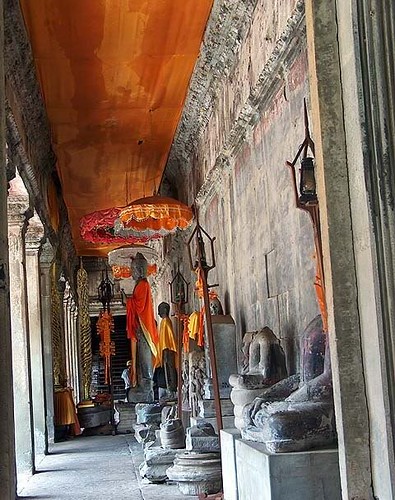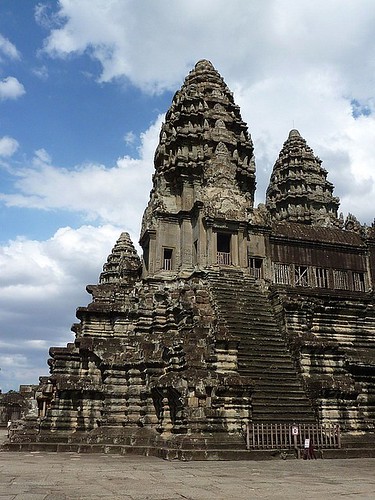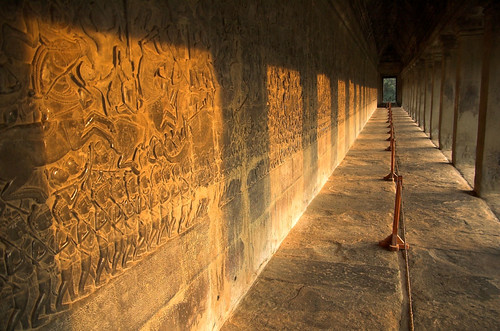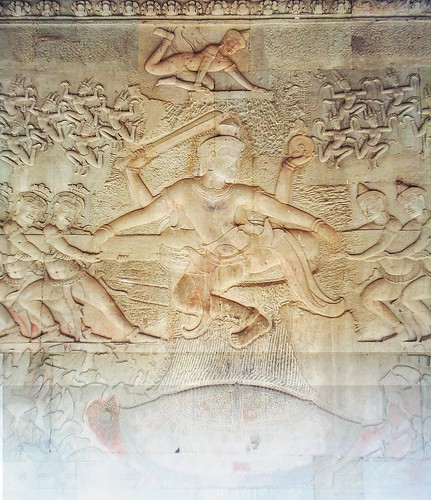Introduction
Angkor derives from a Sanskrit word meaning ‘holy city’; ‘Wat’ in Khmer means ‘temple’. Angkor Wat, located 5.5 km north of the modern town of Siem Reap in northeast Cambodia represents a whole complex of wonderful temples and stonemasonry and artwork throughout this area. It is a UNESCO world heritage site and is one of the most important archaeological sites in South-East Asia besides being the single largest religious structure in the world, and surely one of the world’s wonders of art and architecture.

The temples of Angkor were built by the Khmer civilization between 802 and 1220 AD. From Angkor the Khmer kings ruled over a vast domain that reached from Vietnam to China to the Bay of Bengal. Within an area of 120 sq. miles, the ruins contain some of the most imposing monuments in the world, including about a thousand temples, mainly Hindu and some Buddhist; the ancient city, however, had an extent some three times that size, and was home to perhaps 750,000 people. The structures one sees at Angkor today, more than 100 stone temples in all, are the surviving remains of a grand religious, social and administrative metropolis whose other buildings – palaces, public buildings, and houses – were built of wood and have long since decayed and disappeared. Angkor Wat was re-discovered by a French man about 150 years ago among heavy forestry, ready to become one of the most visited archaeological and artistic sites on the planet.
History
The initial design and construction of Angkor Wat took place in the first half of the 12th century, during the reign of Suryavarman II (1113 – c. 1150). Dedicated to Vishnu, it was built as the king’s state temple and capital city. As neither the foundation nor any contemporary inscriptions referring to the temple have been found, its original name is unknown, but it may have been known as Vrah Vishnulok after the presiding deity. Work seems to have ended shortly after the king’s death, leaving some of the bas-relief decoration unfinished. In 1177, approximately 27 years after the death of Suryavarman II, Angkor was sacked by the Chams, the traditional enemies of the Khmer. Thereafter the empire was restored by a new king, Jayavarman VII, who established a new capital and state temple (Angkor Thom and the Bayon respectively) a few kilometres to the north.
In the late 13th century, Angkor Wat gradually moved from Hindu to Theravada Buddhist use, which continues to the present day. Angkor Wat is unusual among the Angkor temples in that although it was somewhat neglected after the 16th century it was never completely abandoned, its preservation being due in part to the fact that its moat also provided some protection from encroachment by the jungle.
The true history of Angkor Wat was pieced together only from stylistic and epigraphic evidence accumulated during the clearing and restoration work carried out across the whole Angkor site. There were no ordinary dwellings or houses or other signs of settlement including cooking utensils, weapons, or items of clothing usually found at ancient sites. Instead there is the evidence of the monuments themselves.
Angkor Wat required considerable restoration in the 20th century, mainly the removal of accumulated earth and vegetation. Work was interrupted by the civil war and Khmer Rouge control of the country during the 1970s and 1980s, but relatively little damage was done during this period other than the theft and destruction of mostly post-Angkorian statues.
The temple is a powerful symbol of Cambodia, and is a source of great national pride that has factored into Cambodia’s diplomatic relations with its neighbour Thailand, France and the United States. The splendid artistic legacy of Angkor Wat and other Khmer monuments in the Angkor region led directly to France adopting Cambodia as a protectorate on 11 August 1863. This quickly led to Cambodia reclaiming lands in the northwestern corner of the country that had been under Thai control since the Thai invasion of 1431 AD. Cambodia gained independence from France on 9 November 1953 and has controlled Angkor Wat since that time.
Angkor Wat Today
Since the 1990s, Angkor Wat has seen continued conservation efforts and a massive increase in tourism. The temple is part of the Angkor World Heritage Site, established in 1992, which has provided some funding and has encouraged the Cambodian government to protect the site. A survey found that around 20% of the devatas were in very poor condition, mainly because of natural erosion and deterioration of the stone but in part also due to earlier restoration efforts. Other work involves the repair of collapsed sections of the structure, and prevention of further collapse.
Angkor Wat has become a major tourist destination. In 2004 and 2005, government figures suggest that, respectively, 561,000 and 677,000 foreign visitors arrived in Siem Reap province, approximately 50% of all foreign tourists in Cambodia for both years. The influx of tourists has so far caused relatively little damage, other than some graffiti; ropes and wooden steps have been introduced to protect the bas-reliefs and floors, respectively. Tourism has also provided some additional funds for maintenance—as of 2000 approximately 28% of ticket revenues across the whole Angkor site was spent on the temples—although most work is carried out by foreign government sponsored teams rather than by the Cambodian authorities.
Architecture and Style
Angkor Wat is the prime example of the classical style of Khmer architecture—the Angkor Wat style—to which it has given its name. By the 12th century Khmer architects had become skilled and confident in the use of sandstone (rather than brick or laterite) as the main building material. Most of the visible areas are of sandstone blocks, while laterite was used for the outer wall and for hidden structural parts.
Angkor Wat is a unique combination of the temple mountain, the standard design for the empire’s state temples, the later plan of concentric galleries, and influences from Orissa and the Chola of Tamil Nadu, India. The temple is a representation of Mount Meru, the home of the gods: the central quincunx of towers symbolises the five peaks of the mountain, and the walls and moat the surrounding mountain ranges and ocean. Access to the upper areas of the temple was progressively more exclusive, with the laity being admitted only to the lowest level.

Angkor Wat has drawn praise above all for the harmony of its design, which has been compared to the architecture of ancient Greece and Rome. According to Maurice Glaize, a mid-20th-century conservator of Angkor, the temple “attains a classic perfection by the restrained monumentality of its finely balanced elements and the precise arrangement of its proportions. It is a work of power, unity and style.”
Features
Outer enclosure: The outer wall is surrounded by open ground and a moat. Access to the temple is by an earth bank to the east and a sandstone causeway to the west; the latter, the main entrance, is a later addition, possibly replacing a wooden bridge. The outer wall encloses a space, which besides the temple proper was originally occupied by the city and, to the north of the temple, the royal palace. Like all secular buildings of Angkor, these were built of perishable materials rather than of stone, so nothing remains of them except the outlines of some of the streets. Most of the area is now covered by forest.
Central structure: The temple stands on a terrace raised higher than the city. It is made of three rectangular galleries rising to a central tower, each level higher than the last. Each gallery has a gopura (a monumental tower, usually ornate, at the entrance of any temple) at each of the points, and the two inner galleries each have towers at their corners, forming a quincunx.
The outer gallery has pavilions rather than towers at the corners. The gallery is open to the outside of the temple, with columned half-galleries extending and buttressing the structure. Connecting the outer gallery to the second enclosure on the west side is a cruciform cloister called Preah Poan (the “Hall of a Thousand Buddhas”). This area has many inscriptions relating the good deeds of pilgrims, most written in Khmer but others in Burmese and Japanese. The four small courtyards marked out by the cloister may originally have been filled with water. North and south of the cloister are libraries.
Beyond, the second and inner galleries are connected to each other and to two flanking libraries by another cruciform terrace, again a later addition. From the second level upwards, devatas abound on the walls, individually or in groups of up to four. The second-level enclosure may originally have been flooded to represent the ocean around Mount Meru. Three sets of steps on each side lead up to the corner towers and gopuras of the inner gallery. The very steep stairways represent the difficulty of ascending to the kingdom of the gods. This inner gallery, called the Bakan, is a square with axial galleries connecting each gopura with the central shrine, and subsidiary shrines located below the corner towers. The roofings of the galleries are decorated with the motif of the body of a snake ending in the heads of lions or garudas.
Carved lintels and pediments decorate the entrances to the galleries and to the shrines. The tower above the central shrine rises above the ground; unlike those of previous temple mountains, the central tower is raised above the surrounding four. The shrine itself, originally occupied by a statue of Vishnu and open on each side, was walled in when the temple was converted to Theravada Buddhism, the new walls featuring standing Buddhas.
Decoration: Integrated with the architecture of the building, and one of the causes for its fame is Angkor Wat’s extensive decoration, which predominantly takes the form of bas-relief (is a projecting image with a shallow overall depth, for example used on coins, on which all images are in low relief) friezes. The inner walls of the outer gallery bear a series of large-scale scenes mainly depicting episodes from the Hindu epics the Ramayana and the Mahabharata. From the northwest corner anti-clockwise, the western gallery shows the Battle of Lanka (from the Ramayana, in which Rama defeats Ravana) and the Battle of Kurukshetra (from the Mahabharata, showing the mutual annihilation of the Kaurava and Pandava clans). On the southern gallery follow the only historical scene, a procession of Suryavarman II, then the 32 hells and 37 heavens of Hindu mythology.
On the eastern gallery is one of the most celebrated scenes, the Churning of the Sea of Milk, showing 92 asuras and 88 devas using the serpent Vasuki to churn the sea under Vishnu’s direction. It is followed by Vishnu defeating asuras (a 16th-century addition). The northern gallery shows Krishna’s victory over Bana and a battle between the Hindu gods and asuras. The northwest and southwest corner pavilions both feature much smaller-scale scenes, some unidentified but most from the Ramayana or the life of Krishna.
Sarah Widjaja and Saurabh Sud
* * *
Bibliography
1. http://whc.unesco.org/en/list/668
2. http://sacredsites.com/asia/cambodia/angkor_wat.html
3. http://en.wikipedia.org/wiki/Angkor_Wat
4. http://www.autoriteapsara.org/en/angkor/temples_sites/temples/
angkor_vat.html
5. http://www.devata.org/2010/01/angkor-wat-top-shrine-reopens-to-visitors/





مجله سرگرمی ، تفریحی و هنری
https://uniul.ir/art/
Really informative post. I personally thought the written post is well suited and trouble-free for me to go after provided guideline. visit this site to find out more 토토
Like!! I blog quite often and I genuinely thank you for your information. The article has truly peaked my interest. 슬롯머신
This article is very nice as well as very informative. I have known very important things over here. I want to thank you for this informative read. 바카라사이트
I read your post carefully and found something new. Thank you for this post. 파워볼사이트
I extremely appreciate you for imparting such sort of information to us, Please keep offering such kind of decent content! 토토사이트
سرور مجازی یا اختصاصی با آی پی اختصاصی داشته باشند تا با مشکل بسته شدن حسابشان روبرو نشوند
آی پی ثابت برای بایننس
هرمزگان کلید دارای بیش از 2دهه سابقه کاری در زمینه کلید سازی و قفل سازی در تمام مناطق بندرعباس با خدمات شبانه روزی و سیار فعال می باشد
قفل سازی سیار بندرعباس
ترموکوپل ( thermocouple ) یکی از ابزارهای پرکاربرد در اکثر پروژه ها می باشد.
ترموکوپل از دو نوع فلز همسان ساخته می شود و به هم متصل شده اند.
دانلود رایگان pdf کتاب اشنایی با معارف و علوم دفاع مقدس
دانلود رایگان pdf کتاب تاریخ تحلیلی صدر اسلام ویراست دوم نصیری
It’s cold
Take good care of your body. I have good information.
파워볼
Hi I read the article well
I also have good information. Take a look
안전놀이터
Hello, thank you for the good information.
I have good information. I want to take a look.
토토사이트
Nice to meet you. I read the text well. I have good information.
먹튀검증
Hello, I’ve been working with the target db for over 5 years with the work team.
We will always try to profit from sales and marketing with the latest DB.
주식디비
It was really creative
کلاس انلاین زبان انگلیسی
very good
دانلود از یوتیوب
There are some fascinating closing dates on this article but I don’t know if I see all of them middle to heart. There may be some validity however I will take hold opinion till I look into it further.
다이아섯다
What’s Taking place i am new to this, I stumbled upon this I have discovered It positively helpful and it has aided me out loads. I am hoping to give a contribution & assist different users like its helped me. Great job
토토웹 포토존
I am curious to find out what blog system you happen to be working with? I’m experiencing some small security problems with my latest site and I would like to find something more secure. Feel free to visit my website: 텍사스홀덤
Excellent post. I was checking continuously this blog and I’m impressed! Very helpful information specifically the last part. I care for such information much. Support my website: 슬롯머신
View at: 슬롯머신777사이트
I need to to thank you for this great read!! I definitely
enjoyed every little bit of it. I have got you bookmarked to check out new things you post…
I must say you’ve done a very good job with this. Also, the
blog loads extremely quick for me on Chrome. Superb Blog!
Click here: 온라인카지노
Thanks for share amazing content. 더킹카지노
Hope to read more post from you.
Glad to find your article. It’s informative.카지노사이트
Artikel yang menarik! Termaikasih Banyak!
Yuk rasakan keseruan bermain slot online bonus 100% di https://www.daftar7sports.live
Excellent post, very informative. I wonder why the 슬롯머신777사이트 other specialists of this sector don’t notice this. You must continue your writing. I’m sure, you have a great readers’ base already!
Greetings! Very helpful advice on this article! It is the little changes that make the biggest changes. Thanks a lot for sharing! 포커게임
good
about
thank you
yblog00
so nice good
کلاس های خصوصی زبان انگلیسی را میتوان ز سریع ترین راه های برای یادگیری سریع زبان انگلیسی دانست.
در یک کلاس آموزش خصوصی زبان انگلیسی شما به صورت تمام وقت میتوانید زبان را در کنار استاد خصوصی زبان انگلیسی خود بیاموزید و از سرعت اموزش در سیستم تدریس خصوصی زبان انگلیسی نهایت لذت را ببرید
https://charbzaban.com/ریپورتاژ-تبلیغات/با-کلاس-زبان-آنلاین،-می-توان-انگلیسی-یا.html
با شرکت در کلاس مجازی زبان انگلیسی انگلیشدان تجربه تازه را در سریع ترین آموزش آنلاین زبان انگلیسی خواهید داشت. اساتید زبان اموزشگاه انلاین زبان انگلیسی انگلیشدان با مدیریت استاد محسن کشاورزی بهترین کلاس زبان انلاین را برایتان ایجاد میکنند.
I want to voice my appreciation for your kind-heartedness in support of people that have the need for help with that situation. Your real commitment to passing the solution all through appears to be definitely useful and have in every case encouraged folks much like me to realize their objectives. The interesting advice signifies so much a person like me and substantially more to my fellow workers. With thanks; from everyone of us.
고스톱
I really like what you guys tend to be up too.
This type of clever work and coverage! Keep up the superb works
guys I’ve added you guys to blogroll
토토
Medical Examiner Dr. Qin: Silent Evidence comamos ramen lanzado ahora. Márcanos como favorito si no quieres perderte otro nombre de Capitulos of Coreano Dorama
doramasTailandia
iTubeGo YouTube Downloader Crack is a professional audio and video downloader that lets you download videos and music from thousands of streaming sites like YouTube, Facebook, Dailymotion, Vimeo, SoundCloud, and more.
itubego youtube downloader crack license key
تراکتور
very good article
تولید کننده راهبند
I’ve read a few lines from your articles. Your writing abilities are outstanding parallel desktop crack.
I’m impressed, I must say. Really rarely should i encounter a weblog that’s both educative and entertaining, and without a doubt, you have hit the nail for the head.
섯다
Only wanna input on few general things, The website layout is perfect, the written content is rattling superb.
스포츠토토
An impressive share, I just now with all this onto a colleague who was conducting a little analysis during this.
성인웹툰
I have gone through this article named ‘ Walk My World Learning Event’. It was a very informative article. The main feature of this article is the way of writing so that we can easily follow the information.
안전놀이터
Thank you for sharing so nice and helpful ideas, I appreciate your work. Keep it up and I hope to see more posts in the future.
AT&T is a web-mailing platform. It is one of the most popular web-mail platforms that provide most of the features on a single platform. If you encounter any problems while the AT&T Yahoo Mail Login account, contact AT&T customer experts or visit our website for more information.
What a nice article i found , i was looking it for a long time , i been searching it for so long now that i found out really help me.
카지노사이트링크
This type of article will be able to think and analyzed to the readers thats leads them in a bright future.
프로토경기결과
The text is excellent. I hadn’t read anything both meaningful and objective in a long time goldwave crack. For newbies, this is a terrific script. I’ll tell my friends about it if they don’t know where to go.
It’s really nice and meaningful. It’s really cool blog. Thanks for sharing and please update some more information here. Students need to gain relevant ideas about the Courses after 12th. The changing time has provided various career segments through which they can see their future. However, a substantial decision can be taken by evaluating one’s own likings towards the career field. Students can select the courses after completing their 12th as per the subject they had taken in the 12th itself from a career point of view.